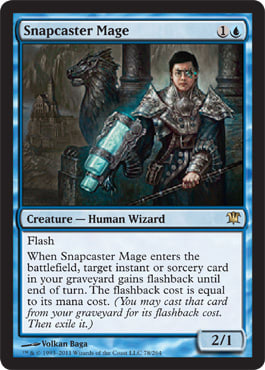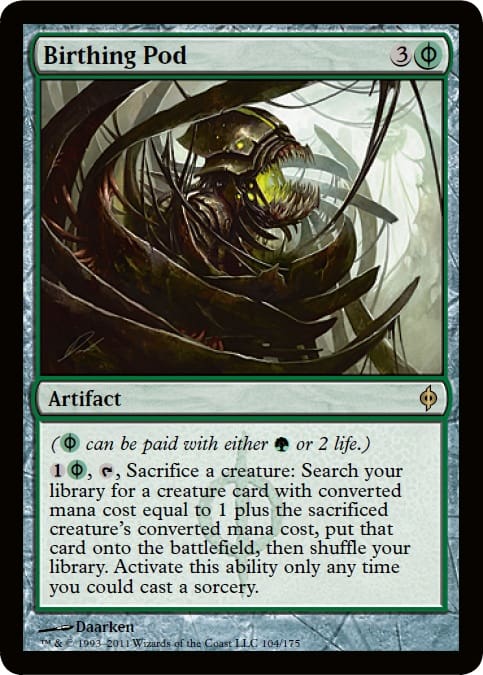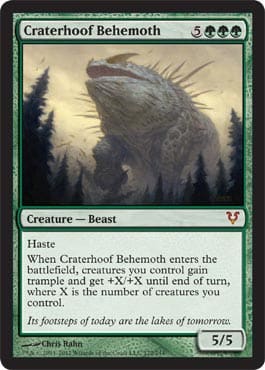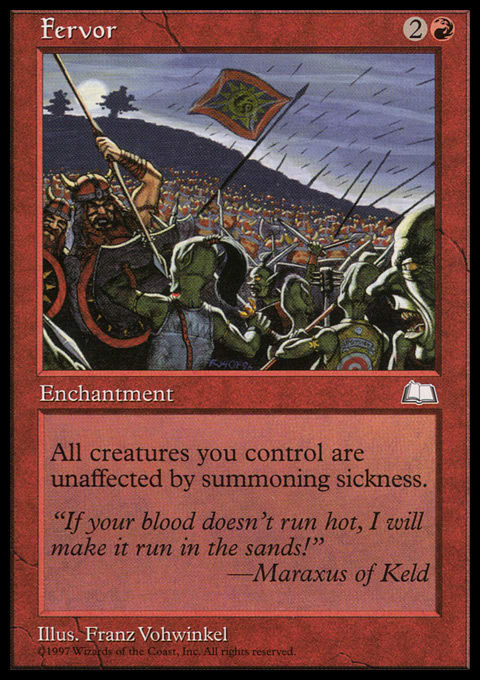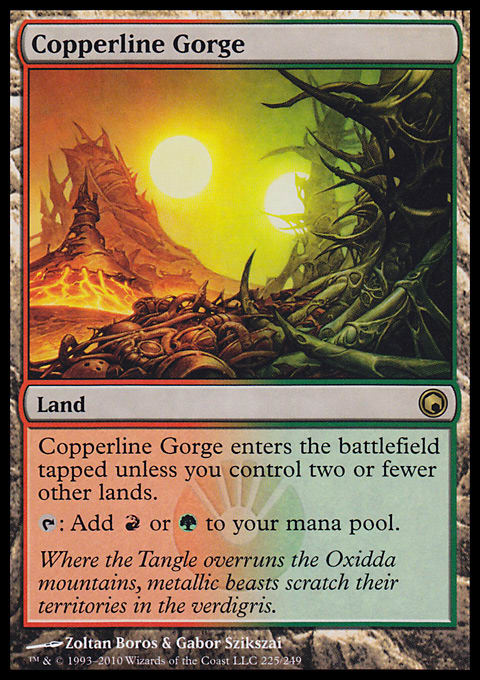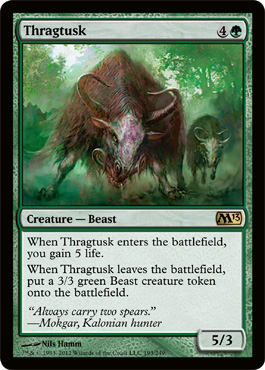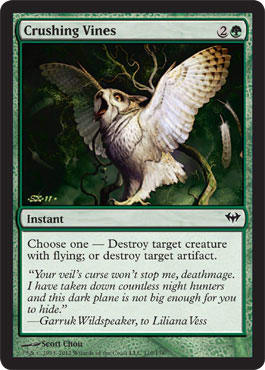Oddly enough, every Friday Night Magic brings with it a new challenge.
This week’s challenge: How am I not done yet?
Ladies and gents, this is week 50 of 52, and while the end has always seemed like something more like a very, very distant dream, now . . . I’m in the 50s, and impatience has kicked in big time. Which is strange, because it’s not as though I’m excited for the column to end or anything, but on the other hand, I am excited to have my Friday nights be my own again. My Netflix queue is getting pretty backed up.
I’d love to get some perspective on FNM from the people who are actually forced to take it seriously, the ones grinding events for the FNM Championships. If I thought the events were a grind for me, what about for the people who actually have to take these events seriously? I’m not saying I didn’t try my best in every event, but when you come into a tournament armed with an Event Deck, or worse, a deck based around Liquimetal Coating, you adjust your expectations accordingly.
At the time I’m writing this, the leader of the current FNM season (dating back to the fifth of last September) is Len Buldt, with 1755 FNM points. For a point of reference, I’ve only missed two FNMs this season, and I have 611 points. I have won six of those FNMs, including the one for this week’s write-up. For yet another point of reference, I’m not even in the top five hundred FNM players this season. This means that not only do you have to show up to FNM every Friday in order to cement your spot at the FNM Championships, but you both have to win every week and have to be playing in an area that either runs massive (we’re talking at least nine rounds) FNMs with a ton of participation points or in an area that has two back-to-back, five-round FNMs.
Somehow, I don’t think this is what they were going for when they set up the FNM Championships. I’m not sure when they made the cut to the invitation list, but it can be found here. We’ll never know whether having an FNM Championship—that players have to qualify for—favors players trying to qualify in big cities or in shops that don’t mind running two FNMs every night into the wee hours of morning. What I can say with some certainty is that playing Magic from 6:00 P.M. to 3:00 A.M. every Friday night and having to take every game seriously (I don’t know how much the top FNM players’ ranks fluctuated throughout the season, but I’m sure they did) takes its toll. At some point, it probably becomes quite the grind—but the players in contention aren’t competing against their FNM opponents, they’re competing against the FNM season standings. Their hapless FNM opponents, who probably went to FNM to relax and have fun, catch the brunt of the FNM grinders’ quests to qualify for the FNM Championships. Not the best situation for either player.
That said, I don’t know if doing away with the FNM Championships completely is the best thing to do. I do know, though, that it’s a system that’s pretty easy for players to both abuse and become burnt out on. “Burnout” and “FNM” should never be thought of in the same idea, but here we are. The only way to qualify for it is to play for hours, into the morning, every Friday night. For Wizards of the Coast, it’s worth examining whether that’s what they really want it to be all about.
I played Bant Pod last week.
"Bant Pod"
- Creatures (32)
- 1 Acidic Slime
- 1 Deceiver Exarch
- 1 Frost Titan
- 1 Geist-Honored Monk
- 1 Mist Raven
- 1 Sun Titan
- 2 Borderland Ranger
- 2 Phantasmal Image
- 2 Thragtusk
- 3 Elvish Visionary
- 4 Avacyn's Pilgrim
- 4 Birds of Paradise
- 4 Blade Splicer
- 4 Restoration Angel
- 1 Phyrexian Metamorph
- Spells (4)
- 4 Birthing Pod
- Lands (24)
- 2 Island
- 2 Plains
- 7 Forest
- 2 Gavony Township
- 3 Seachrome Coast
- 4 Hinterland Harbor
- 4 Razorverge Thicket
That’s Cedric Phillips’s exact list from the Pro Tour Qualifier he won in Seattle and his primer on the deck, which can be found here. Read that if you want to learn how to play the deck; I can’t really do the deck any better service than Cedric does.
What I can tell you is that Birthing Pod has been the cornerstone of five decks I’ve played in the duration of this column. I’ve played Naya Pod, R/U/G Pod, the B/G Event Deck that had two Birthing Pods in it, Zombie Pod, and now Bant Pod. I would guess that Birthing Pod and Snapcaster Mage, each being two elite card-advantage engines that encourage players to build whole decks around them, have accounted for somewhere around twenty percent of the decks I’ve played during this column. Both engines are easy enough to interact with—Birthing Pod is an artifact, while Snapcaster Mage’s value is gutted by graveyard hate. One card is bolstered by efficient spells and the other by efficient creatures, most of which feature undercosted enters-the-battlefield abilities.
When Michael Jacob completed the first-ever Birthing Pod deck (which can be found here) last summer, he unwittingly laid out the blueprint for Birthing Pod decks to use into the next year—by setting up the mana curve of his creatures as a chain in order to maximize the effectiveness of Birthing Pod. When you look at the deck on paper, a weird card like Deceiver Exarch doesn’t make much sense, when in actuality, it lets you go straight from a 2-drop to a 4-drop, speeding up your chain by a whole turn. Thanks to Clone effects and Restoration Angels, a single Deceiver Exarch in a Birthing Pod deck can speed up the chain by two whole turns, as Cedric details in his Bant Pod primer.
As I’ve said before, I’m not in love with Birthing Pod as much as everyone else seems to be; it makes decision trees very clear, and this slows a lot of people down when they play. If there’s one thing I can’t stand when I’m playing Magic, it’s when my opponent is playing slowly. This is why I apologize whenever I tank for a while on my turn; I can’t stand it when my opponent draws his card for the turn and then sits there agonizing over his play as though it’s the first time he’s been presented with the game state that’s been in front of him the whole time. This is my problem, not my opponent’s, but that is my weak reasoning as to why I don’t like Birthing Pod. Another weak reason I hate Birthing Pod is that I hate linear strategies, which is all a Birthing Pod deck is; I’d rather mess my opponent up directly with a spell than indirectly with some big threat that he has to answer.
However, I did like the sound of Cedric’s 10–0–2 PTQ record, so I brought Bant Pod to my local Wednesday Night Standard.
I split the finals and didn’t drop a single game on the way. Guess those linears are pretty damn good. I went into FNM with first place dead in my sights.
Round 1 – Noah Watkins
Noah is the son of Cloud City owner Jeff Watkins. He is very quiet and respectful, which is rare for a thirteen-year-old. He just picked up Magic and is an eager sponge for the game, always coming in to work with his dad, looking for games against whomever might be hanging out.
He’s playing a mono-black deck, with the majority of cards in it coming out of Magic 2013.
I don’t love writing about games against newer players because they aren’t usually close—or fun—and they make me very self-conscious about being a terrible teacher. Noah ends up making Game 2 pretty close, though; I keep a one-lander on the draw on the virtue of it having two Avacyn's Pilgrims, and his double–Tormented Soul draw gets me down to 1 until I can stabilize behind a wall of Frost Titans. On the turn after I kill him, he draws a lethal Geralf's Messenger. Kid’s gotta learn life’s unfair sometime.
1–0
Round 2 – R.J. Fischer
R.J. is on that mono-green Elf deck with Craterhoof Behemoth, or as Steve Sadin put it in his Avacyn Restored preview, Craterpoop Behemoth. To be fair to Steve, I didn’t see that card being very good either.
R.J. starts Game 1 with a second-turn Ezuri, Renegade Leader and plays two more Elves on his third turn. I have the Phyrexian Metamorph for it, and his draw craps out without Ezuri, Renegade Leader, as that deck is wont to do, while I lock him out with Gavony Township. There’s a little part of me that wants Wizards to just bring back all the nonbasic lands that were in the first Ravnica block for the Return to Ravnica; I hate G/W as a color combination, but goddammit, I loved me some Selesnya. Can you imagine Vitu-Ghazi, the City-Tree and Gavony Township simultaneously legal in Standard? If that doesn’t make you want to do your best Evan Erwin impression as you call that combo “fuh-reakin’ suh-weet,” well then GO HOME because YOU DON’T BELONG HERE.
Game 2 is awesome; R.J. mulls to four and keeps:
Isn’t Arbor Elf neat?
I make a lot of Acidic Slimes and do not lose this match despite the fact that a resolved Craterhoof Behemoth against me usually signals the end of the game in favor of my opponent.
2–0
Round 3 – Josh Campbell
A while ago, I wrote about feeling bulletproof in a Magic tournament, like no one can touch you, and you’re just gonna cruise to first and there’s nothing anyone can do about it; it’s already predetermined. But feeling invulnerable is a double-edged sword.
Allow me to set the stage for you: It’s Game 3. Josh is on the play, and after a mulligan to six, he’s staring across the table at a turn-four Thragtusk, courtesy of our hero. Josh untaps, draws, tanks for a little bit, and casts a Wolfir Silverheart, pairing it to his Birds of Paradise, before attacking with his 4/5 Birds of Paradise and passing the turn back to me.
I look up at Josh. He’s eyeing the board intently.
I got this.
“Phantasmal Image, copying Thragtusk?”
Josh is a bit annoyed, which is justified, because the only thing more obnoxious than a Thragtusk is a 2-mana Thragtusk.
“Sure,” Josh says.
I turn my Thragtusk sideways. “Just him.”
Josh tanks. I let him think for a bit. I glance down at the Crushing Vines in my hand. I got this.
“Oh . . . shhhoot,” I say softly.
Josh instantly blocks with his Wolfir Silverheart. I tap three lands and show him Crushing Vines.
“Kill your Birds?”
Josh reflexively moves his Wolfir Silverheart back an inch, and I look up and see his grasp of reality slowly and steadily eat itself.
Ten full seconds pass. “Our guys trade,” I remind him. We bin our creatures.
“Your turn.”
Josh quietly checks his library for a miracle on his draw step, and he draws his card. He sits there for a whole two minutes before saying,
“That wasn’t even a good acting job.”
To which I burst out laughing. Because it’s true, it wasn’t a very good acting job! It was one of the stupidest, most bush-league moves I’ve ever pulled in a sanctioned game of Magic, and it only happened because losing never really crossed my mind.
3–0
For whatever it’s worth, the correct play would’ve been to try to let him attack with the Wolfir Silverheart and then block and Crushing Vines, but my confidence gave way to recklessness. It was very memorable, though. And totally bush-league. I would be remiss if I didn’t emphasize that fact.
Round 4 – Matt Brown
Matt’s playing a R/U/G Delver deck with both Quirion Dryad and Bonfire of the Damned in it, and once I realize this, my confidence evaporates. Quirion Dryad can quickly get to a point at which it just trumps all of my creatures, Bonfire of the Damned just destroys me, and an early Insectile Aberration is really too fast for me to race.
Game 1 feels like it’s done before it starts; Matt wins the die roll, and his turn-one Delver of Secrets transforms without any help. He also sets up a miracled Bonfire of the Damned on his third turn, netting him a very early two-for-one. However, Matt quickly floods out, and my hand is a bunch of Thragtusks and Restoration Angels, none of which he has countermagic for.
Matt offers up much less resistance in Game 2, as he mulligans to five on the play and inadvertently mills the lone Thragtusk (weird!) in his deck with an errant Thought Scour.
4–0
I end up splitting the finals and getting first on breakers.
50 down; 2 to go. I’ll see all you smiling faces next week.
Jon Corpora
Pronounced Ca-pora













